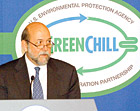
Robert J. Meyers, principal deputy assistant administrator of the EPA’s Office of Air and Radiation, announces the formal launch of GreenChill.
A ceremony took place in late fall in Washington, D.C., at which time major supermarkets joined with the EPA and others “to show that protecting the stratospheric ozone layer is cool - literally,” according to a statement from the EPA.
Formally, EPA joined with the supermarket, refrigeration equipment, and chemical refrigerant industries to launch GreenChill Advanced Refrigeration Partnership, billed as “a voluntary program to promote green technologies, strategies, and practices that protect the stratospheric ozone layer, reduce greenhouse gases, and save money.”
“As Americans make greener choices, we look for companies that support a greener lifestyle,” said Robert J. Meyers, principal deputy assistant administrator of EPA’s Office of Air and Radiation. “The GreenChill logo is a clear sign of a supermarket’s environmental commitment. It shows that GreenChill members are doing their utmost to save the ozone layer.”
The 10 GreenChill founding partners are: Whole Foods Market; Food Lion LLC; Giant Eagle Inc.; Hannaford Bros. Co.; Harris Teeter; Hill Phoenix; Honeywell International; Kysor/Warren; Publix Super Markets Inc.; and DuPont.
These partners, as well as those in the future, said Meyers, must pledge to go above and beyond regulatory requirements by establishing an inventory of current refrigerant emissions that may affect climate change and the stratospheric ozone layer, and then setting reduction targets for these emissions. Partners will also participate in an industry/government research initiative to assess the performance of green technologies in terms of energy efficiency, reduction of ozone-depleting refrigerant charges, and minimization of refrigerant leaks.
EPA estimated that widespread adoption of advanced refrigeration technologies, best practices, and improved equipment design and service could reduce refrigerant emissions by 1 million metric tons of carbon equivalent per year, the equivalent of taking 800,000 automobiles off the road every year.
To counteract the depletion of stratospheric ozone, Meyers said, partners guarantee to use only ozone-friendly alternatives and advanced refrigeration technologies in all new and remodeled stores.
EPA believes that GreenChill partners’ adoption of advanced refrigeration technologies will lead to increased energy efficiency and reduce operating expenses to the industry by over $12 million annually.
FIRST ANNOUNCEMENT
Bringing GreenChill into reality has been ongoing for several years.The actual first announcement of GreenChill took place in September 2006 at the Food Marketing Institute Energy and Technical Services Conference.
For many years before that, supermarkets had been focusing on new equipment designs, new refrigerants, stepped up preventive maintenance, and given more attention to refrigerant recovery in response to environmental and cost concerns.
In many cases, supermarkets were able to plug what they had been doing into the GreenChill criteria, while in some instances, the same criteria have provided a framework for future projects, that may be undertaken by store designers, installers, and service companies.

Currently the supermarket industry is exploring several different approaches to creating cooling and freezing in stores. The long-used direct expansion method is sharing attention these days with secondary loop and distributed approaches.
For the record, the EPA has not been favoring one approach over the other, as the agency’s main concern is for stores to use the most up-to-date equipment that focuses on energy efficiency and refrigerant containment.
For more information, visit www.epa.gov.
Publication date:03/10/2008

